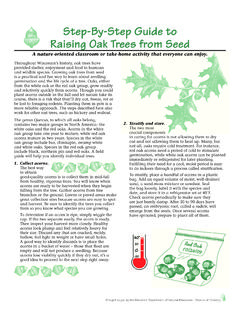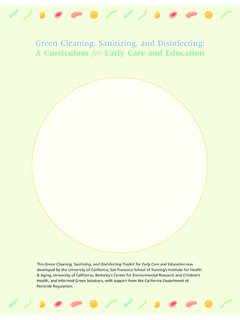Transcription of Infection of Seed & Transmission of Seed Borne Pathogens
1 Infection of seed &. Transmission of seed Borne Pathogens Lindsey du Toit WSU Mount Vernon NWREC. seed Borne vs. seed transmitted seed Borne microorganisms: - saprophytic - pathogenic - opportunistic seed Borne microorganisms: - fungi - bacteria - viruses - nematodes Classes of seed Borne microorganisms 1. Infected seed = primary inoculum source. If seed Infection is controlled, the disease is controlled 2. Important pathogen, but infected seed = minor source of inoculum 3. Seedborne microorganisms never demonstrated to cause disease 4. Pathogens that infect seed in fields or in storage, & reduce seed quality Attributes of seed transmitted organisms Ability to gain access to seed Ability to survive commercial processes Harvest, cleaning, treatment, storage Ability to establish on emerging seedlings Primary or secondary Transmission Biological factors that affect these attributes Infection method(s).
2 Timing of Infection of seed crop Nature of pathogen biotroph, necrotroph Survival structures or states nematodes cryptobiosis, cysts fungi and Chromistans - sclerotia, microsclerotia, oospores, chlamydospores Ability to gain access to seed Active process of Infection - within seed Passive access present on seed surface contaminant in seed lot Affects ability to clean or treat seed Routes of active seed Infection stigma style pollen tube ovary wall (pericarp). ovule ( seed ). nucellus egg sac testa ( seed coat). egg cell (embryo). micropyle vascular trace funicle (from Maude, 1996). (funicular scar = hilum). Routes of active seed Infection A. Penetration through ovary wall C.
3 Penetration through floral parts B. Systemic Infection via vascular system : Cladosporium variabile (spinach), Botrytis spp. (onion). : Ustilago nuda (grains). : Vascular wilt fungi, Cucumber mosaic virus From Maude (1996) endophytes Direct systemic Infection via vascular system Many viruses, : PSbMV on pea LMV on lettuce AMV in alfalfa PEBV in pea Some fungi, : Vascular wilts (Verticillium dahliae, Fusarium oxysporum). some downy mildews Few bacteria, : X. campestris pv. campestris Direct connection between embryonic & endospermic tissue becomes disconnected as seed develops Potential for Transmission affected by degree of internal Infection Direct systemic Infection of seed Neotyphodium coenophialum in seed next to the embryo.
4 Systemic Infection of plants. Whole life cycle occurs inside tall fescue (mutualism). K. Gwinn, UT. seed Borne Verticillium dahliae in spinach Systemic Infection from roots or seed du Toit et al., 2005. Plant Dis. 89:4-11. Non-inoculated control Inoculated with V. dahliae Indirect systemic Infection via stigma to embryo Pathogen moved from infected plants to flowers May follow pollen pathway to embryo sac Examples: pollen Borne viruses LMV, CMV (some hosts). infected pollen may be less viable (poor fertilization). Nepoviruses Loose smut fungi (Ustilago tritici). Ergot fungi, not seed transmitted but ergots can be mixed with seed Lower rate of pollen vs. ovule Transmission (LMV).
5 Pollen tube entry into seed Examples: 1. loose smut of small grains 2. CMV in spinach Certification programs, host resistance, systemic fungicides Indirect Infection via flower or fruit Weak necrotrophs: Botrytis cinerea - infected petals remain attached to developing fruit Aggressive necrotrophs: Attack floral parts directly , Ascochyta pisi, Alternaria brassicicola peduncle fruit coat (ovary) dorsal suture funicle*. seed coat Fleshy fruits ( , Solanaceae) seed attached to central placenta - infect via calyx - placenta funicle embryo Umbelliferae & Liliaceae flowers exposed in umbels seed Transmission is typically discontinuous ( Infection outside embryo). - affected by intrinsic & environmental conditions Brassica seed Alternaria brassicicola & A.
6 Brassicae Correlation of severity of pod spot with: seed germ = , seed rot = + du Toit & Derie, 2003. Fung. & Nem. Tests 58:V026. Leptosphaeria maculans (black leg). seed Borne Stemphylium botryosum &. Cladosporium variabile in spinach Hernandez-Perez & du Toit. 2006. Plant Disease 90:137-145. du Toit & Hernandez-Perez . 2005. Plant Disease 89:1305-1312. Botrytis scape & flower blight of onion B. B. squamosa B. byssoidea Mohan seed Borne Botrytis aclada & B. allii in onion Bacterial leaf blight of carrot Xanthomonas campestris pv. carotae Pathogens use multiple points of access? Acidovorax avenae subsp. citrulli bacterial fruit blotch of watermelon Possible mechanisms of seed infestation by A.
7 Avenae subsp. citrulli A. Penetration through ovary wall C. Penetration through B. Systemic Infection via floral parts vascular system No evidence ?? Role of female watermelon blossoms in Acidovorax avenae subsp. citrulli seed Infection Walcott et al. Phytopathology 93:528-534. seed Borne Pathogens : Implications for risk analysis Epidemiology of the pathogen - Potential for seed Transmission - Conditions for disease development & spread - Ease of eradication Alternative sources of inoculum - Infested residues - Soilborne inoculum - Infected adjacent or overwintering crops or weeds In-field control measures - Resistant cultivars - Fungicides & forecasting - Crop rotation - Plant spacing, row orientation - Irrigation (system & schedule).
8 Threshold(s) for seedborne inoculum - Environmental conditions? - Resistant vs. susceptible cultivars? Potential for seed Transmission Environmental factors - temperature*. - moisture*. - light - pH. - soil microflora - degree of internal Infection of seed Genotype - host resistance, maternal vs. paternal - pathogen isolate/strain Inoculum potential - amount of inoculum & conduciveness of environment - Transmission rate - threshold(s) for seedborne inoculum - complex, lack of adequate field research seed Borne inoculum thresholds Xanthomonas campestris pv. Cylindrocladium parasiticum in campestris peanuts 1 in 30,000 seed 1 in 400 seed = VA. Increases asymptomatically threshold before epidemic in field Significance of seed Borne carrot Pathogens Umesh et al.
9 , 1998. Plant Dis. 82:1271-1275. Bacterial blight in central CA. Threshold of ~104-105 CFU/g seed in semi-arid central CA. seed Borne Pathogens : Implications Alternative inoculum sources for seed Borne carrot diseases - Infested residues (Alternaria dauci in CA) (Gilbertson et al.). - Soil Borne inoculum (Alternaria radicina = 8 years). - Infected adjacent or overwintering crops or related weed hosts (X. campestris pv. carotae in carrot seed crops in PNW). du Toit et al., 2005. Plant Dis. 89:896-907. Influence of relative humidity on Transmission of leaf spot fungi from spinach seed Mean % seed Transmission (% of infected seed planted). Fungus Trial 1 (RH ~95%) Trial 2 (RH ~75%).
10 C. variabile ( ) ( ). S. botryosum ( ) ( ). Alternative sources of inoculum for S. botryosum in spinach seed crops Pleospora herbarum on surface spinach stem residues du Toit & Derie, 2003. Phytopathology 93:S22. Influence of environment on seed Transmission of Botrytis aclada/B. allii in onion 60. 50 1973 (dry summer). % Bulbs with neck rot 1974 (wet summer). 40. 30. 20. 10. 0. 1 10 20. % seed infected with B. allii Tichelaar, 1967; Relationship between infected seed & post-harvest neck Maude & Presly, rot in the UK (from Maude & Presly, 1977b). 1977a Ellerbrock & Lorbeer (1977): Field Infection sources were more important in NY than infected seed . 60. Treated with benomyl % Bulbs with neck rot in storage 50.





